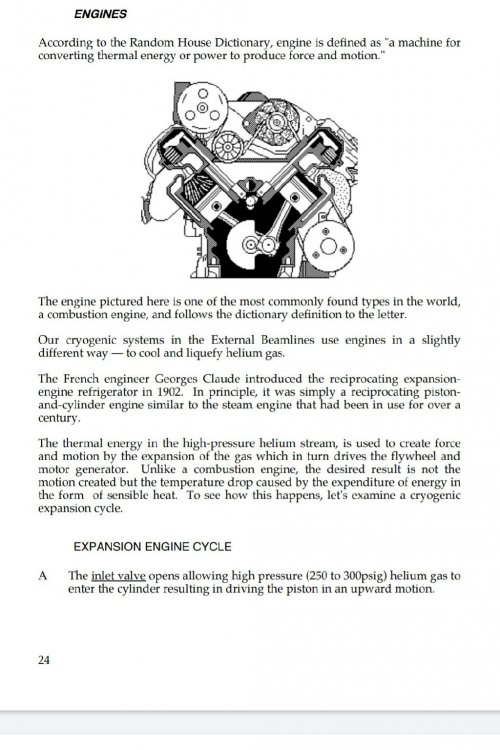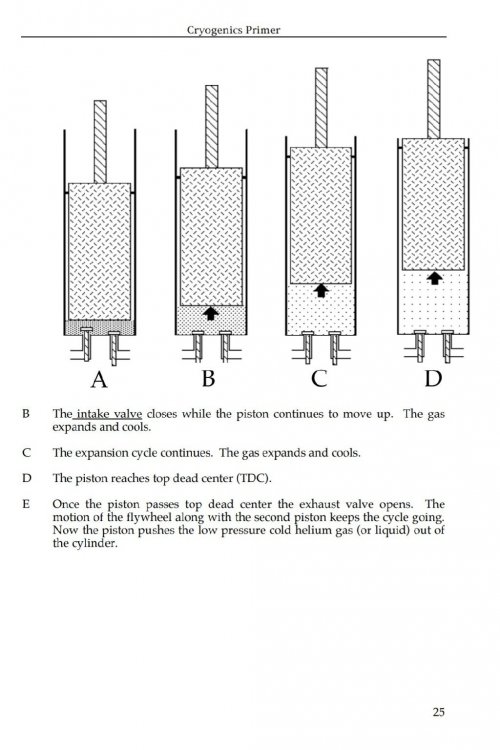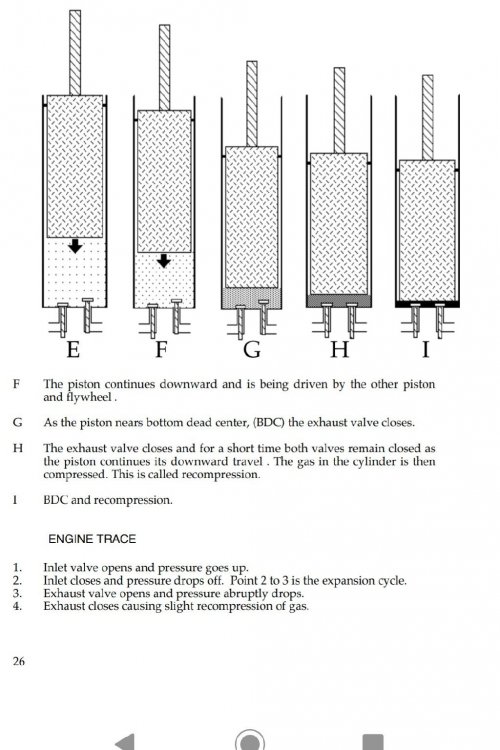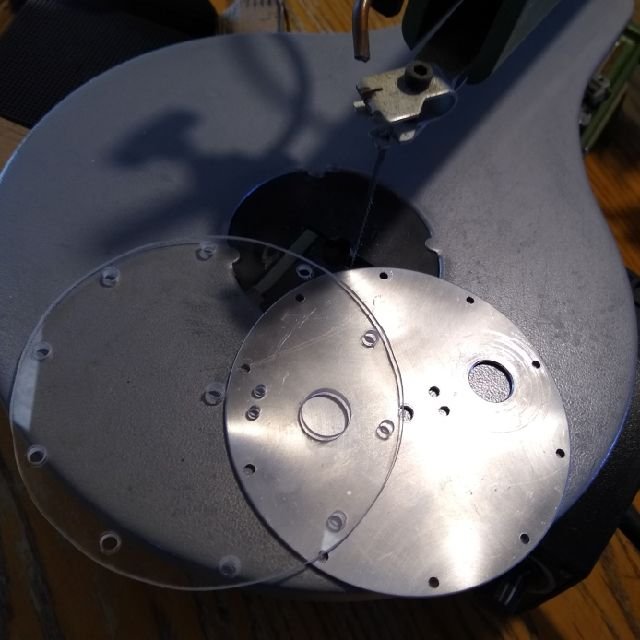-
Posts
456 -
Joined
-
Last visited
Content Type
Profiles
Forums
Events
Everything posted by Tom Booth
-
OK, that makes sense, I think. So then, as far as using the formula, it doesn't matter that adding heat does not produce useful work in this situation. Rather, removing heat stores potential energy in the water, which if then allowed to freeze, can crystalize and lift a weight as heat is lost? Can the sign just be ignored and change the negative (heat rejected) to positive? Or is it necessary to measure the heat absorbed by the ice in melting and use that number. Or doesn't it matter? I feel like my brain is getting a whiplash trying to follow the logic of all this. Then would W/Qh be identical to W/Qc, one can't just be substituted for the other can it? I should have said, or my intended meaning was: " I don't think expansion volume is a determinant of the available energy" - all by itself. Of course. I guess. An engine is a vessel designed to easily "rupture" in such a way as to perform work by means of a moveable wall; the piston, attached to a crankshaft or whatever. The "ice bomb" engine would have to be similarly constructed. Something like a very strong hydraulic jack. The impracticality of the small distance traveled might be overcome by attaching the piston to some kind of long extended lever.
-
That assumes some cooling apparatus. As already stated, that is not the case. The process could, for example be taking place in winter, or at the north pole where below freezing temperature is the prevailing condition. To have a complete cycle, it can be assumed the engine must contact a higher temperature reservoir to re-melt the ice, but no energy is expended in freezing or thawing as far as calculating efficiency is concerned. The Carnot model of an ideal heat engine assumes the pre-existence of two "reservoirs" of different temperature, neither of which needs to be created. "Efficiency" depends "only" on the difference in temperature and does not address in what way that difference came into existence. I don't think expansion volume is a determinant of the available energy. For example, if I lift a ping pong ball ten feet and a ten ton block of concrete 0.5 inches, which one of the two has the greater potential energy?
-
The Joule–Thomson effect, used in refrigerators and heat pumps and in the liquefaction of gases. (Linde process) The air, held back in the mouth under increased pressure does result in higher temperature, higher kinetic energy, which quickly equalizes with the body temperature and is carried off by the blood stream, so when the air finally escapes, it can expand and reclaim the lost heat. That is to say, it is now colder due to having previously lost heat while under pressure. the air also does a bit of work while escaping, pushing the outside air aside. So a bit of the Claude system of refrigeration as well.
-
A cold reservoir. Not an energy source. An energy sink.
-
An "Ice bomb" is made by filling a very strong iron container with water and freezing it. As water freezes it expands in volume exerting a force of some 100,000 pounds per square inch. The "ice bomb", usually a grenade shaped cast iron container, when frozen, will explode with tremendous force. If contained within a wooden box when it explodes, it will destroy the box. A conventional hot air or heat engine similarly utilizes the property of a gas that expands and exerts a force with a change in temperature. A gas is heated in a cylinder and the expanding gas expands and drives a piston. Could a thermal engine be constructed that utilizes the property of water to expand when frozen, taking advantage of the same force that causes the "ice bomb" to explode? If not, why not? We know that the efficiency of a heat engine is represented by the formula: efficiency = W/Q hot or the work output of the engine divided by the heat input. In the case of the theoretical ice bomb engine, however, Q hot is negative as heat is taken away to cause the ice to expand and output useful work. Therefore, is the efficiency of the "Ice bomb" engine also negative? Can the efficiency of a thermal engine be less than zero, yet still operate? It seems clear to me that by containing water as it freezes and expands, useful work could be extracted.
-
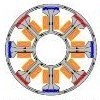
Heat engine experiments and 2nd law of thermodynamics.
Tom Booth replied to Tom Booth's topic in Speculations
I believe I already have. By simply insulating the cold plate, which is where the engine's refrigeration winds up, to prevent ambient heat infiltration, the same way an ice box is insulated, the "sink" or cold plate getting colder, demonstrably causes the engine to run better and faster. Why not just carve it out on some stone tablets? Sorry, but I don't need this, there ia a multitude of forums I could be posting to that don't have such nonsensical restrictions. Close the thread if you want boo hoo. Your loss.- 85 replies
-
-1
-

Heat engine experiments and 2nd law of thermodynamics.
Tom Booth replied to Tom Booth's topic in Speculations
"demonstrate"? How? I was recording experiments so the results could be known to everyone, with as little interpretation on my part as possible, but apparently posting video is frowned upon here, if not outright grounds for expulsion, so, who can possibly demonstrate anything with such restrictions? -

Heat engine experiments and 2nd law of thermodynamics.
Tom Booth replied to Tom Booth's topic in Speculations
Direction of rotation. In other words, if a Stirling engine were operated, turning clockwise, putting energy into a big giant external flywheel, then the heat source was removed, and the flywheel continued to drive the engine, in the same clockwise direction, the engine would then be functioning as a refrigerator. This is not any different than what takes place, or can, take place, as a result of a Stirling engine storing energy in its own flywheel, then proceeding through the remainder of the cycle on that stored momentum. -

Heat engine experiments and 2nd law of thermodynamics.
Tom Booth replied to Tom Booth's topic in Speculations
It has been my observation that the Stirling engine cycle is functionally equivalent to the expansion refrigerating engine described above. The comparison is appropriate. What exotic machinery? A Stirling cryo-cooler is essentially the same machine as a Stirling engine An expansion engine is similarly not at all "exotic" or complicated. It is simply any piston in a cylinder driven by the expansion of a gas. -

Heat engine experiments and 2nd law of thermodynamics.
Tom Booth replied to Tom Booth's topic in Speculations
Expansion engines are used in cryogenic refrigeration. It IS a variety or type of refrigeration, just not one many people are familiar with. This is from a public domain document: https://operations.fnal.gov/rookie_books/Cryo_Primer.pdf -

Heat engine experiments and 2nd law of thermodynamics.
Tom Booth replied to Tom Booth's topic in Speculations
. How does that post violate any rule? The video is highly relevant to the discussion, the relevant points are written out and quoted in the text of my post. The relevant content is at the very beginning of the video, nobody is required to watch the entire video, or any of it for that matter to participate in the discussion, the video and the point being made are certainly open to discussion, it is the point of the discussion. It is not MY video, is not in my YouTube lineup at all, so it's not to boost my YouTube ranking which is not even monetized I've read the rules pertaining to videos and have complied in every possible way Videos as supporting material are useful and add to the discussion. This used to be, years ago, quite a friendly forum, but if simple links and videos are so intolerable here now, it has become less useful IMO. What rule specifically does my previous post violate? None that I'm aware of. The same way it normally does. 1. By converting heat into work. Heat converted to work is heat that is absent, otherwise known as cold. 2. Momentum in the piston is utilized for expansion. When a gas is mechanically expanded it cools. The engine is doing the same thing, the same processes are taking place, but by eliminating the heat input and driving the engine mechanically, everything takes place at a "lower octave" so to speak. The same cycle at a lower temperature. In reality, a Stirling engine, as part of its normal functioning, is a kind of refrigeration machine. -

Heat engine experiments and 2nd law of thermodynamics.
Tom Booth replied to Tom Booth's topic in Speculations
I've been looking for some kind of "authoritative" confirmation of my statement, that a Stirling cryo-cooler is THE SAME as a Stirling engine running in The SAME direction as a Stirling engine, as very often, there is quite a bit of misinformation on the internet that a Stirling cooler runs in the opposite direction from a Stirling engine. There is, at least, this old video: This does not seem to be a very well documented point of fact. "The machine running in the same forward direction in both cases". -

Heat engine experiments and 2nd law of thermodynamics.
Tom Booth replied to Tom Booth's topic in Speculations
Yes, I do plan on getting some sort of temperature probes. I don't know of anywhere locally that would carry that sort of thing. Anyone have any recommendations? Something thin preferably, that maybe could be taped to the hot & cold plates. The first engine is still intact, except for having stripped off the insulation for that video. I'm building another engine. This time my plan is to add Regenerator matrix. I'm not sure what you mean by, let us deal with the simple machine first. My time for working on this stuff is very limited, so when I have time, I'm not just going to twiddle my thumbs. -

Heat engine experiments and 2nd law of thermodynamics.
Tom Booth replied to Tom Booth's topic in Speculations
Good point. The hot bottom plate was insulated everywhere except between that and the Dewar flask mouth, so indeed that certainly cut down on heat loses from the hot plate, which would have made it hotter. However, thinking about it, the bottom periphery had been insulated the whole time as well s the whole Dewar and all. The increase in RPM took place after the cold plate was covered. The sides of the engine are mostly a short section of plexiglass tubing, so is not very conductive, but the air spaces between the nylon bolts could transfer heat between the plates by convection. So that was insulated. Also, I had run the engine with the same setup, insulation everywhere, except on top. If I'm not mistaken, it ran faster and longer only after the top was insulated, everything else being the same, but I was not being as careful as I should have been, and times of day, ambient temperature, and probably other variables were not well controlled. That is why I ordered so many kits, to run engines side by side at the same time, but I only have one built so far. What I do know for sure is after I covered the sink, the RPM increased, which was what my theory told me might happen but was the opposite of what everyone else thought would happen. Really if the engine did not continue running and instead speeded up as it did, I would have discarded the whole theory and nobody would be seeing this. -

Heat engine experiments and 2nd law of thermodynamics.
Tom Booth replied to Tom Booth's topic in Speculations
I've decided to see what happens if the aluminum cold plate, which might sink a lot of heat even insulated, is replaced with plexiglass, which is over 1000 X less heat conducting. -

Heat engine experiments and 2nd law of thermodynamics.
Tom Booth replied to Tom Booth's topic in Speculations
In regard to these experiments, this article is also significant: https://www.stirlingengine.com/#5 The section on Stirling cryo-coolers. There is also additional information on Stirling coolers in the FAQ on this website. What is important to understand, I think, is that a Stirling cryo-cooler is not a Stirling heat engine "running backwards". As a cooler, the engine runs in the same direction as for power output. It functions in almost exactly the same way, mechanically, as a cooler as it does as an engine. A Stirling engine is really a refrigeration device that works by converting heat into work to effect cooling. Running the engine with a motor, the same way, in the same direction, simply amplifies the cooling effect, so that the engine can produce much colder temperatures, all the way down to the cryogenic range. The effect in a small toy engine is so minute, though, it requires very careful insulating to produce any measurable effect. -

Heat engine experiments and 2nd law of thermodynamics.
Tom Booth replied to Tom Booth's topic in Speculations
The picture/animation originated here: http://www.bekkoame.ne.jp/~khirata/english/anime_c.htm There is a ton of information on that site, as well as the American Stirling Engine site. Originally I had wanted to, and intended to order engines from the ASE company, but their website was inaccessible at the time. The animation is overly simplistic and does not really begin to delve into the thermodynamics of the engine. For example, the illustration shows water cooling of the top plate, which is common. But imagine that instead of cooling the top plate with water, it were insulated, as in my experiment, which would, presumably, retain most of the heat from the burners. Without the active cooling, one might expect the engine to overheat and quit working. But in my experiment, that is not what happened. Insulating the top, instead of cooling it, did not cause the engine to quit. Instead it ran measurably better. Something else was keeping the top plate cold. Something not shown or discussed on that page. -

Heat engine experiments and 2nd law of thermodynamics.
Tom Booth replied to Tom Booth's topic in Speculations
In talking about Stirling engines there are some technical terms that can't be avoided. "Displacer" is one. It is, as far as I know, unique to Stirling heat engines. I've explained the function of the displacer in as many ways as possible and from as many different angles as possible. Displacement is not a common word, but the dictionary definition for displacement describes what the displacer does in a Stirling engine. It makes no difference what I say or how I say it, if you don't know the technical terminology and what it means in the context of Stirling engines, it will have no meaning There is nothing wrong with my sentence structure. Sorry, I think your post slipped in and I did not see it until now. Sounds great. And it IS fair to drop in on the middle of a conversation you haven't been following and start criticising because you don't know what's being discussed? It helps to go back and read and find out what you may have missed. Discussions progress. Usually. The topic is "Heat engine experiments and 2nd law of thermodynamics." Notice the plural in "experiments"? The "s" at the end of the word means more than one. -

Heat engine experiments and 2nd law of thermodynamics.
Tom Booth replied to Tom Booth's topic in Speculations
A closer look at the displacer. As can be seen, just a thin, lightweight, loose fitting disk of styrofoam. -

Heat engine experiments and 2nd law of thermodynamics.
Tom Booth replied to Tom Booth's topic in Speculations
You can be deliberately obtuse and try to drag this out but my sentence is perfectly clear. I was referring to THE DISPLACER!!!- 85 replies
-
-1
-

Heat engine experiments and 2nd law of thermodynamics.
Tom Booth replied to Tom Booth's topic in Speculations
In case you missed my edit above: Here it is again: Edit: as a matter of fact, this was my statement: You left off the bolded and underlined part I had emphasised. Why? You copy pasted completely out of context. -

Heat engine experiments and 2nd law of thermodynamics.
Tom Booth replied to Tom Booth's topic in Speculations
We can discuss whatever you like, but let's just try to be clear what is being discussed. I'm talking about an engine running on hot water, and you interject, so why does the ice melt. It's like I'm talking about a submarine and someone asks about the airplane wings I mentioned in another conversation two days ago. One thing has nothing to do with the other. I may have said something like that, or possibly those words exactly, but that is out of context. It is true though that no mechanical element, not the displacer, not the piston, is doing work to expand the gas. HEAT expands the gas and the GAS does work as it expands. So that is probably a perfectly valid statement in context, as Studiot was talking about the piston and displacer at the time if I'm not mistaken. Would it be a valid statement to say that the heat does work? I don't think so, but it might be a way of looking at it. Edit: as a matter of fact, this was my statement: You left off the bolded and underlined part I had emphasised. Why? -

Heat engine experiments and 2nd law of thermodynamics.
Tom Booth replied to Tom Booth's topic in Speculations
You aren't or haven't been following the conversation. Much earlier Studiot said the displacer: "drives the crank via what I would call a push rod". I'm just trying to clarify the function of the displacer. It does not drive the crankshaft, it is in no way in direct contact with atmosphere. I'm not trying to say no work is being done by the piston, I'm trying to clarify the function of a displacer. The marbles are the displacer! You are the one who is not focused on what the topic of the conversation is and not getting what is being talked about. Nobody says no part of a Stirling engine does work against the atmosphere. Exactly, thank you. "The displacer only moves the air back and forth from the hot side to the cold side. It does not operate the crankshaft and the engine. In other words, the connecting rod to the displacer could be a string in this engine and it would still work." -

Heat engine experiments and 2nd law of thermodynamics.
Tom Booth replied to Tom Booth's topic in Speculations
What? I have no idea what you're driving at. What plunger? What "two conditions?" What does a vacuum have to do with anything? How is work being done against outside atmospheric pressure by those marbles rolling back and forth. Yes their rolling away from the heat source causes the displacement of the air which results in increased pressure in the test tube, but the pressure has no effect on the marbles, they are isolated from the atmosphere. The DISPLACER has ample clearance around it and air moves freely around it, it does not form any seal or work against any pressure. -

Heat engine experiments and 2nd law of thermodynamics.
Tom Booth replied to Tom Booth's topic in Speculations
I was just trying to clarify that "work" is not done to expand the gas, or to work against atmospheric pressure BY THE DISPLACER. The displacer is not any kind of power piston. Imagine an empty soup can. Completely sealed, containing a gas. Inside the can is another smaller loose fitting soup can. If you tip the can on one end, gravity will cause the inside can to fall to the bottom so the air in the can will be DISPLACED to the top. Tip the can around the other way, again the can inside falls and DISPLACES the air back to the opposite end. Now heat one end of the can. Do the same flip flop and the inside can, or "displacer", still DISPLACES the air in the can but now, when the air is displaced to the hot side the air gets hot and the pressure in the can increases. Tip the can the other way and the air is displaced to the cold side, cools down and the pressure in the can drops. Hopefully, it can be seen that the small can inside is not performing any appreciable work to turn a crankshaft or to work against the pressure of the outside atmosphere. It is just a means of periodically delivering heat to the inside of the can to heat the air and create pressure. It does this by moving away from the heated end of the can, displacing the air to the hot end, or put another way, simply uncovering the hot heat exchanger. Often, in a Stirling engine the displacer is not attached to the crank at all. It may be moved back and forth by other means, such as a magnet., Or in some cases by actually tilting the engine. Here the displacer is some marbles in a test tube. They full back and forth by gravity, have no connection to any crank and do not work against atmospheric pressure. They just displace air to the heated side of the engine periodically.


